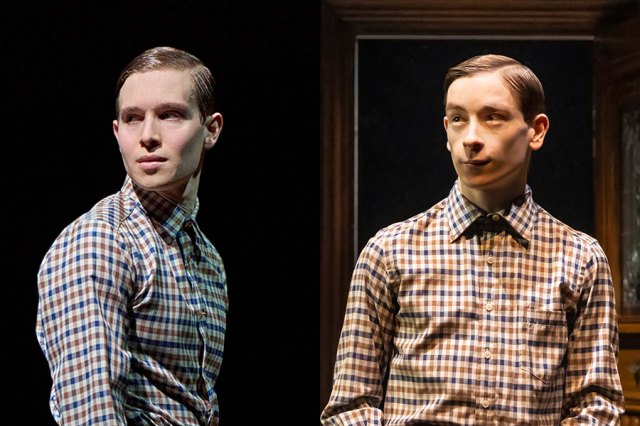Dream and Reality Converge in Eugene O'Neill's Long Day's Journey Into Night
Jeremy Irons and Lesley Manville bring the tortured Tyrones to Brooklyn’s BAM Harvey Theater.
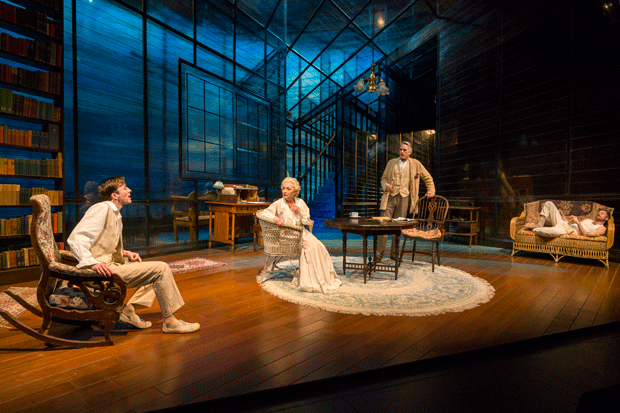
(© Richard Termine)
This month, New York audiences have a rare chance to see two of Eugene O’Neill’s best plays, The Iceman Cometh and Long Day’s Journey Into Night, in award-worthy stagings. The second of these is Richard Eyre’s outstanding Bristol Old Vic production, which just arrived at the BAM Harvey Theater after a run in the West End. Lesley Manville and Jeremy Irons lead the cast as Mary and James Tyrone, the long-suffering couple whom O’Neill based on his own parents. Their performances brim with anguish and gritty realism, while Eyre’s direction adds a dreamlike patina to this story of regret and opioid addiction, a theme that resonates more today amid America’s own devastating opioid crisis.
The play takes place on a single day in 1912 at the Tyrones’ seaside summer home in Connecticut. Tightfisted retired actor James Tyrone and his wife, Mary, are worried about the health of their son Edmund, who has contracted an illness that may be tuberculosis, though Mary denies it’s more than an ordinary cold. Jamie, their ne’er-do-well son who has come home from the bars and brothels of New York to sponge off his folks for a while, doesn’t help matters as he needles his father about being a tightwad who got Mary hooked on morphine after trying to save money by sending her to a quack doctor. Mary has recently returned from a stay in a sanatorium to overcome her drug addiction, but now her husband and sons suspect that she is relapsing.
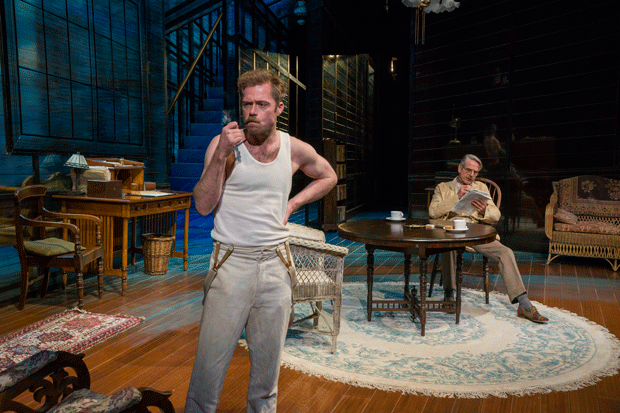
(© Richard Termine)
As the day wears on and the house is swallowed by night and a fog that rolls in off the ocean, the men begin drinking whiskey as Mary sneaks off to her room for a fix. Tongues are soon loosened, and anger over regrets and past offenses spills into the open as the family members toss memory grenades into the room, blaming one another for their unhappiness and unfulfilled dreams.
Irons (who bears a resemblance to O’Neill himself in this production) growls and snarls in his gravelly voice, reverberating with rage and resignation, while Manville, in a tour-de-force performance, reels off Mary’s repetitive litany of grievances against James. Irons and Manville’s vibrant onstage chemistry brilliantly illuminates James and Mary’s stubborn, unbreakable love even as they hurl accusations and recriminations at each other. Irons’s performance is notable for capturing the silent gestures buried in O’Neill’s work that only a great actor could tease out. As Edmund makes an offhand remark to Mary, James angrily waves him away without her seeing. Family arguments, Irons shows us, often take place behind our backs.
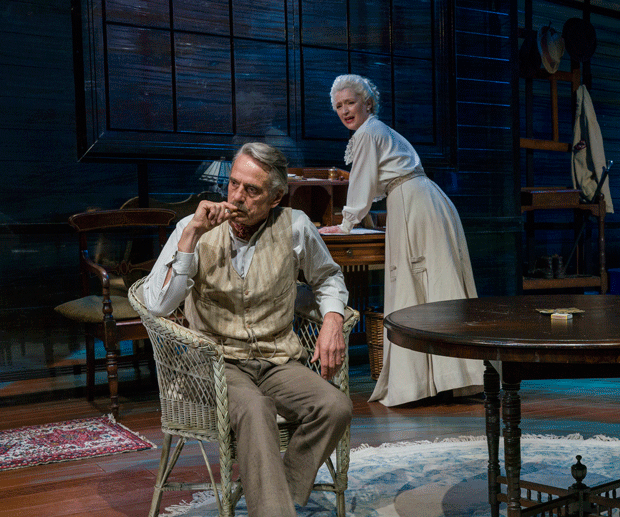
(© Richard Termine)
Manville captures the unconscious tics (the clutch of a shawl, the picking at a pillow) of a person who has spent too much time alone. As Mary becomes ever more drug-addled and lost in her broken dreams of becoming either a nun or a concert pianist, she delivers torrents of words that blur the line between thought and speech. Mary will speak to anyone who will listen, even the maid Cathleen, played with earthy pertness by Jessica Regan. Eyre poignantly shows us how Mary’s loneliness has gradually made her into the ghost of herself in the final scene, where she glides quickly around a dark corner like a gothic specter in her white nightgown (costumes by Rob Howell) and plays a song on the piano. This tragic vision is what her husband and sons have feared all along.
Though Eyre’s direction keeps the action moving despite voluminous passages of dialogue, the play’s second half sputters during the long scene between Edmund and James. Matthew Beard has the challenge of making Edmund (the character O’Neill based on himself) into an engaging presence onstage, and the opportunity to do this comes near the end in Edmund’s long speech about the sea, which Beard delivers haltingly as he sits restlessly in a chair. “Yes, there’s the making of a poet in you all right,” says James to his son afterward. Unfortunately, we’re not as convinced. Rory Keenan, however, jumpstarts things when he enters as a very drunk Jamie. His fiery performance and the scene’s verbal and physical violence remind us that the Tyrones are always one shot of whiskey away from tearing one another to pieces.
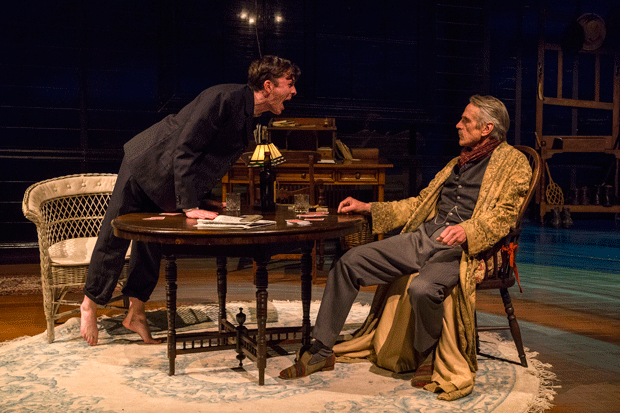
(© Richard Termine)
A mingling of the present and the dreamlike past is on display in the physical design as well. Howell’s expressionistic set for the Tyrone home — with its translucent, oddly angled walls and an absurdly high bookcase that towers crookedly to the high ceiling — has the surreal look of a building in a Fritz Lang film. Peter Mumford’s gauzy, silvery-blue light during the evening scenes casts an eerie glow over the Tyrone house like a shadowy nightmare, and with John Leonard’s groaning foghorn in the background, the house itself seems like it has drifted out to sea.
Fortunately, this production does not drift. At about three-and-a-half hours, this Long Day’s Journey Into Night feels like a vital work for our times as we examine issues (opioid addiction, sexual misconduct, abuses of power) that we, like the Tyrones, have been more or less in the fog about. Though O’Neill wrote the Tyrones as a way to come to terms with his pain, we should look at them as a reminder of how we need to address our own.
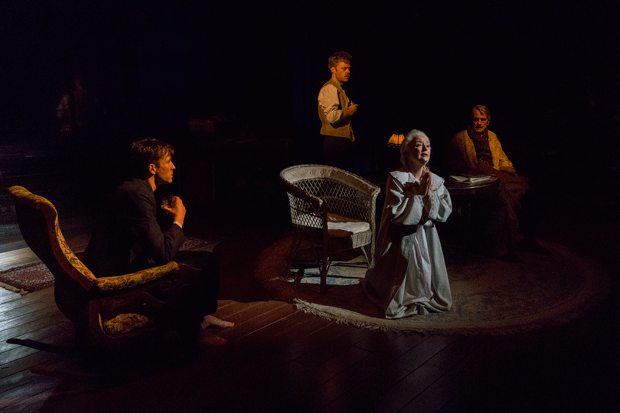
(© Richard Termine)









